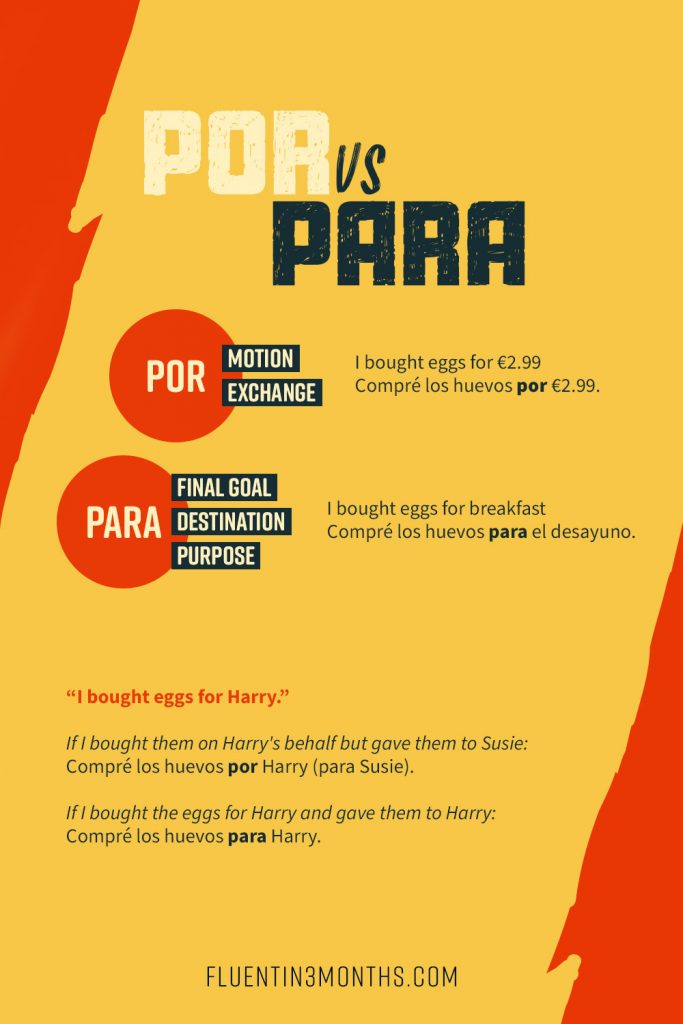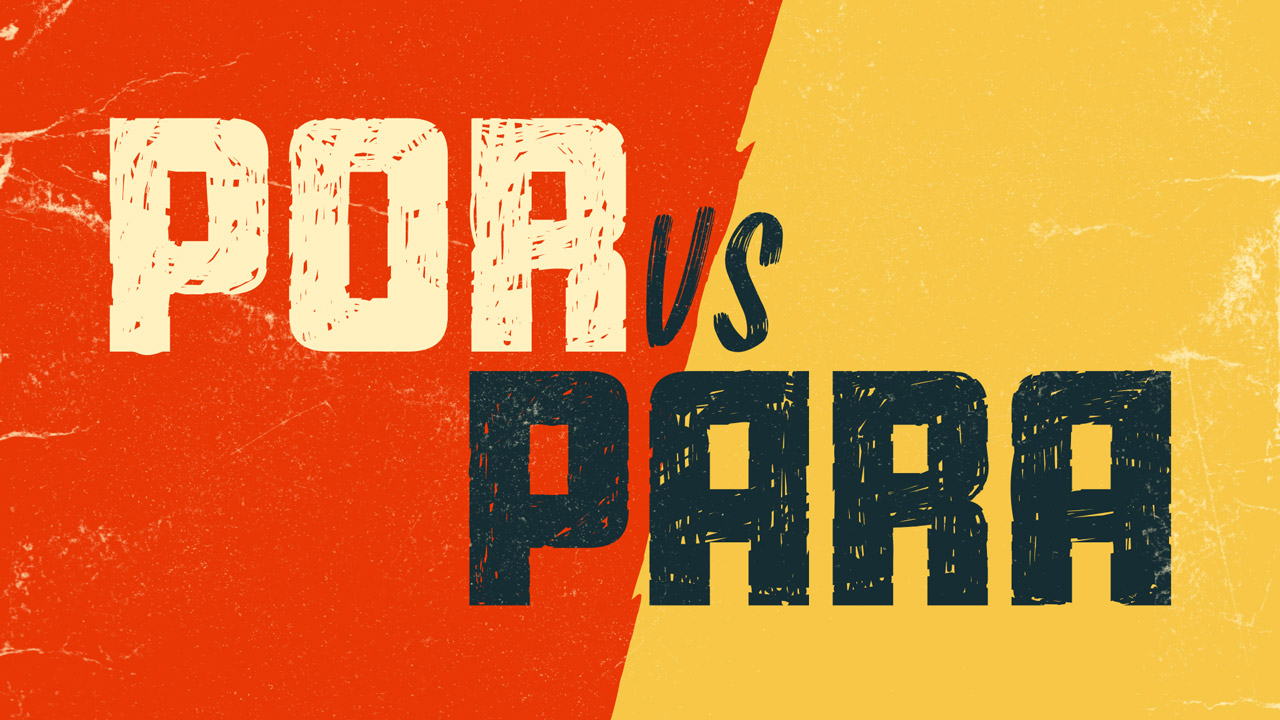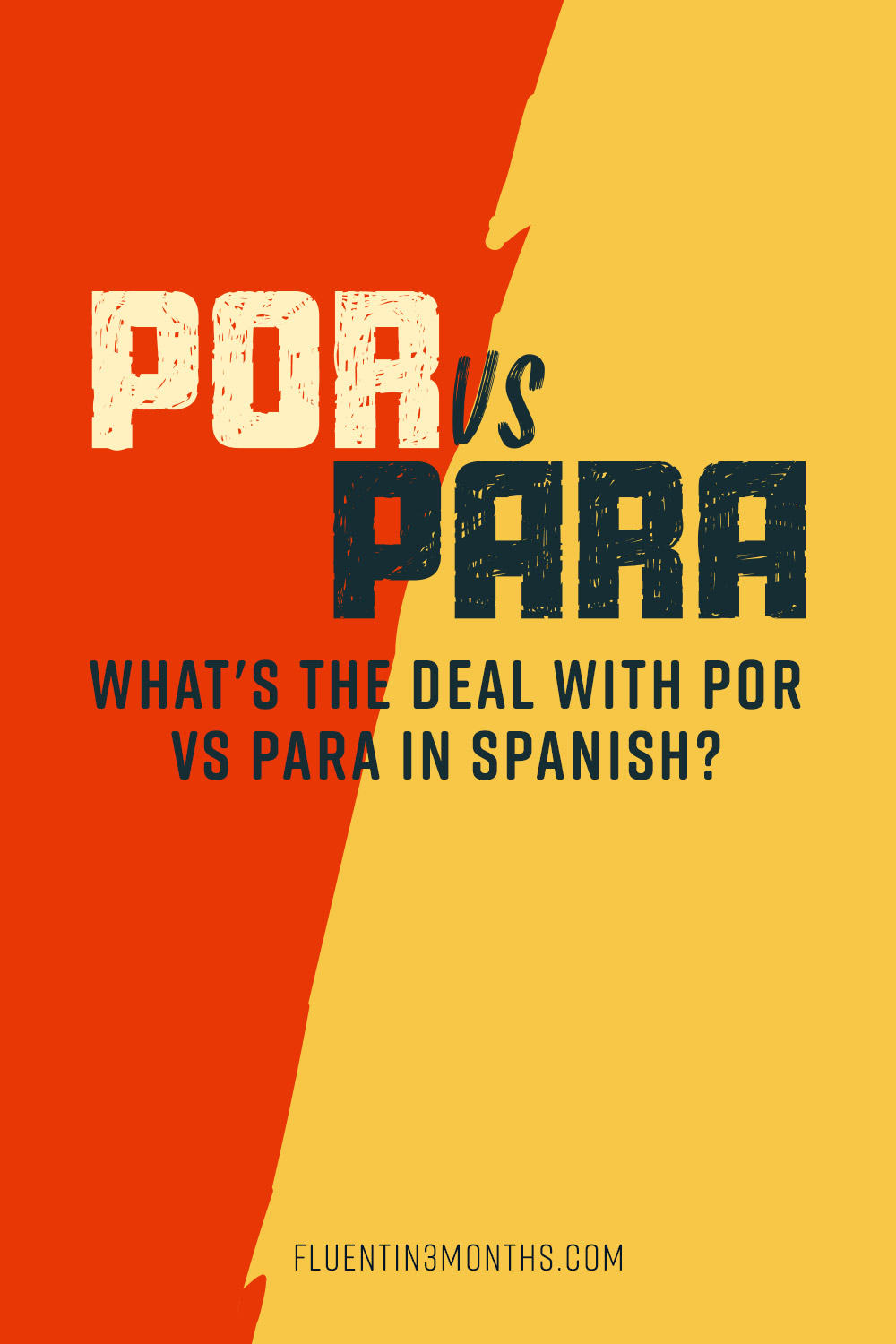Por vs. Para in Spanish: The Ultimate Guide
What’s the deal with por vs. para? That’s a common question from Spanish learners.
That makes sense, because the difference between the words por and para is one of Spanish’s more difficult aspects. But I’m here to help you understand it all.
Here’s a quick overview: Most of the time, both por and para translate to the word “for” in English. But para expresses a final goal, destination or purpose. Por conveys a motion or an exchange.
Don’t worry, we’ll go more into detail throughout the post.
And because I’m all about language hacking, I’ll teach you an easy hack to make the difference between por and para in emergency situations.
In fact, here’s what we’ll cover:
Table of contents
- Por vs. Para: Why There Are Two Words for “For” in Spanish
- A Helpful Por vs. Para Hack for Right Now
- A Longer Term Por vs. Para Hack
- Por and Para: The Basic Rules
- Do Some Sentences Work With Both Por and Para? – The Case of Doing Something On Someone’s Behalf
- How to Have Por or Para on the Tip of Your Tongue
- Online Quizzes to Check Your Por vs. Para Progress
- You’re on Your Way to MasterPor and Para!
Let’s dive in!
Por vs. Para: Why There Are Two Words for “For” in Spanish
You might be thinking: Why does the language require so many rules just to say something that can be explained with one word in English? If we can get by in English just saying “for”, why do we need two separate words in Spanish?”
Before you start thinking that Spanish is the “weird” language of the two, have an objective look at the English word “for”. Why do we use just this one word to describe many different ideas?
Look at these three sentences:
- “I bought eggs for breakfast.”
- “I bought eggs for €2.99.”
- “I bought eggs for Harry.”
Try explaining to a student of English why the heck we use the word “for” in all three of these sentences! It actually makes less sense to do it this way than to use different words for different contexts.
It seems like Spanish has the right idea!
Like any “difficult” language feature, the usage of por and para just takes a bit of practice to get right.
Let’s dig into how you can learn the difference between them.
A Helpful Por vs. Para Hack for Right Now
Para has far fewer uses than por. This means you can employ an easy hack to get you using these words in your Spanish conversations as quickly as possible.
It’s simple: just learn the rules for para, and then you can assume that any scenario not covered by the para rules uses por instead.
I’ll get to these rules in a moment. I just wanted to reassure you first: it can be quick to reach a “good enough” stage in using por and para. Is this a perfect hack? Nope! But it’s a quick one!
It will get you out and using por and para, at a pretty decent level, right now.
A Longer Term Por vs. Para Hack
Over time, you should study all of the usage rules of each word so that you can fine-tune your skills and learn to use each word like a pro.
The best way to do this, in my experience, is to create a flash card deck.
Pick an app like Anki or Flashcards Deluxe. Make sure that it uses a spaced repetition system to help you learn more quickly.
Next, gather as many sentences as you can find that use either por or para. The ones I list later in this article are a good start, but don’t stop there. The more examples you find, the faster you’ll learn how to use each word naturally and without a second thought.
Put the English sentence on one side of each card, and the Spanish translation on the other. When studying, translate each sentence into Spanish, out loud.
Trust me, after some days of regular practice, you’ll be using por and para like a native speaker.
Por and Para: The Basic Rules
Now let’s get down to business.
What are the actual rules for using each word? Instead of explaining all of the different usage rules, I’m going to start with some examples. They should make the rules more clear once I do explain them.
Take a look at the following Spanish para sentences and their English translations. Don’t skim them; read each one, and its translation, carefully.
When to Use Para – Examples and Rules
- Estoy estudiando biología para entrar a la escuela de medicina – “I’m studying biology to get into medical school.”
- Estoy aquí para hablar con Sam – “I’m here to talk to Sam.”
- Ellos construyeron el nuevo puente para aliviar la congestión del tráfico – “They built the new bridge in order to alleviate traffic congestion.”
- El autobús sale para Santiago en diez minutos – “The bus leaves for Santiago in ten minutes.”
- Parto para Francia mañana. – “I depart for France tomorrow.”
- Programé una cita médica para el lunes – “I made a doctor’s appointment for Monday.”
- Por favor, ten el artículo listo para mañana – “Please have the article ready for tomorrow.”
- Tejí este suéter para mi madre – “I knitted this sweater for my mother.”
- Esta canción es para ti – “This song is for you.”
- La música es demasiado ruidosa para mí – “The music is too loud for me.”
- Hago ejercicio para mi salud – “I exercise for my health.”
Can you see a pattern in all of these sentences? They all have something in common.
The word para seems to convey the same idea in each sentence, even though the context is different. The meaning that para conveys is that of a final goal, destination or purpose.
This could be a person (Tejí este suéter para mi madre), a deadline (Por favor, tener el artículo listo para mañana), or a result (Ellos construyeron el nuevo puente para aliviar la congestión del tráfico).
One more thing: When you see para followed by an infinitive verb, para means “to” or “in order to”.
Examples:
- Vine aquí para comer – “I came here to eat.”
- Estoy leyendo el libro para mejorar mi español – “I’m reading the book in order to improve my Spanish.”
This is one of the most common uses of para, and you can clearly see how it conveys a sense of purpose.
Quick exercise: in my three English “egg sentences” at the beginning of this article, which ones have the idea of a goal or purpose?
- “I bought eggs for breakfast” – Compré los huevos para el desayuno.
- “I bought eggs for €2.99.”
- “I bought eggs for Harry.”
Look at the first one. What was the purpose of the eggs? To be my breakfast. So this sentence translates into Spanish with the word para: Compré los huevos para el desayuno.
That’s really all there is to it for the word para.
Next time you’re chatting in Spanish and you’re not sure whether the sentence needs por or para, think back to the idea of a destination, goal or purpose. Is there a single endpoint, or an objective, in the sentence?
If so, then you can be fairly confident that para is the right choice.
When to Use Por – Examples and Rules
Now check out these sentences that use por:
- He vivido en Colombia por cinco años. – “I lived in Colombia for five years.”
- Veo la televisión por una hora todos los días. – “I watch TV for one hour every day.”
- Pasé el día caminando por las calles de San Francisco – “I spent the day walking through the streets of San Francisco.”
- Hoy solamente, puedes comprar dos pizzas por $ 10 – “Today only, you can buy two pizzas for $10.”
- Lo hice por respeto – “I did it for respect, or “out of respect”.”
- Te pagaré el martes por una hamburguesa hoy – “I’ll pay you Tuesday for a hamburger today.”
- Mi hermano estaba enfermo, así que cuidé a los niños por él – “My brother was sick, so I babysat the children for him (instead of him).”
- Me encanta el esperanto por su gramática sencilla – “I love Esperanto for its simple grammar.”
- El juego fue cancelado por la lluvia – “The game was cancelled due to rain.”
- Alquilamos un lugar más grande por el número de personas – “We rented a bigger venue because of the number of people.”
- No me gusta hablar por teléfono – “I don’t like talking on the phone.”
- Estoy por la libertad de expresión – “I’m in favour of / I am for free speech.”
- El cuadro fue pintado por Picasso – “The picture was painted by Picasso.”
What’s the pattern here? Well, there are actually several, and some of them are a bit more subtle than the para pattern.
The main idea with por is that it’s used in sentences that convey the sense of motion. This “motion” could be a duration of time, a movement through a physical place, or an exchange of some sort.
The first seven sentences above use por to convey this meaning of motion.
(Note: Some of my example sentences use por to describe a length of time. That’s the case with He vivido en Colombia por cinco años. This use of por is more common in Latin America than in Spain. In European Spanish it’s more common to say He vivido en Colombia durante cinco años.)
Quick quiz. Let’s go back to my eggy sentences from earlier in this post. Why do you think the second sentence, “I bought eggs for €2.99”, would use por?
In this case, the meaning conveyed is of an exchange. The eggs cost €2.99, so I paid €2.99 in exchange for the eggs. This exchange is the “motion” referred to in the sentence.
This is the main usage of por, but there are several other ways to use it:
- to indicate a cause or reason for something — e.g. Me encanta el esperanto por su sencilla gramática (“I love Esperanto due to its simple grammar.”)
- to refer to a way or means of doing something — e.g. No me gusta hablar por teléfono (“I don’t like talking via phone.”)
- to express support for something — e.g. Estoy por la libertad de expresión (“I am for free speech.”)
- to say who performed an action in a passive construction – e.g. El cuadro fue pintado por Picasso (“The picture was painted by Picasso.”)
This might be difficult to wrap your head around at first. As I said before, por is more complex than para. There are certainly quite a few more uses for por than there are for para.
So make your life easier by getting comfortable with para first.
Do Some Sentences Work With Both Por and Para? – The Case of Doing Something On Someone’s Behalf
Look at my three eggy sentences again.
- “I bought eggs for breakfast” – Compré los huevos para el desayuno.
- “I bought eggs for €2.99” – Compré los huevos por €2.99.
- “I bought eggs for Harry.”
I still haven’t covered the third one: “I bought eggs for Harry.” Do you think this should use por or para?
Arguably, this sentence conveys a sense of destination or purpose. Harry receives the eggs, but I bought the eggs and gave them to Harry. So Harry’s the goal, or destination, in the sentence.
In this case, the translation would be Compré los huevos para Harry.
But when you think about it, the English sentence is ambiguous. Am I really going to give the eggs to Harry? Maybe Harry asked me to buy eggs and give them to Susie.
In that case, I’m still doing it “for” Harry; I’m buying them on his behalf. If this is the case, you’d use por. Compré los huevos por Harry.
If this isn’t clear, imagine how Harry might phrase this request: “Please buy eggs for Susie for me.” Notice how the word “for” is used twice, but means something different each time.
In Spanish this sentence would be Por favor, compra huevos para Susie por mí.
Do you see? This shows how the difference between por and para lets you convey more meaning in Spanish than with the English word “for”.
Why do we only have one word in English again?

How to Have Por or Para on the Tip of Your Tongue
However you choose to go about learning these two words, don’t opt for trying to memorize all the rules before using the words in real life. It would be a waste of time.
That’d be a bit like reading a book about how to knit, and then sitting down with your knitting needles and expecting to end up with a decent pair of socks. Not gonna happen!
It’s better to use the words at the same time as you’re learning the rules.
Make a flash card deck using the above sentences. Put both the por and para sentences into one deck, to help you practise the difference). Practise it often. Translate the sentences out loud into Spanish. When you make a mistake, then go back and check the rules.
By doing this, you’ll develop an instinctive understanding of when to use each word.
Online Quizzes to Check Your Por vs. Para Progress
In addition to flash cards, there are lots of online quizzes you can practise with. Here are a few:
- StudySpanish.com – The best quiz for beginners. Each sentence is translated into English for students who aren’t completely comfortable reading Spanish yet.
- SpanishDict Practice Quiz – My favourite. For both your right and wrong answers, the quiz gives you a very clear explanation for the answers. It gives you feedback as you go, so your performance will improve as you continue with the test. By the last ten questions, you’ll probably be getting 100% of the answers correct!
- 123 Teach Me – This is a tougher test, for more advanced Spanish speakers. Instead of individual sample sentences, you read a narrative and fill in the blanks with either por or para as you go. You’ll have to write them down on paper; you can’t type them in on the page. Then you can check your results on the Answers page.
You’re on Your Way to MasterPor and Para!
Finally, for a bit of fun, take a look at this list of common Spanish expressions containing por and para, which you’ll hear a lot in Spanish.
Por and para in these expressions don’t necessarily follow the rules above. Don’t sweat over them too much though! As long as you speak Spanish with real people on a regular basis, you’ll hear these expressions often enough that their usage will soon start to feel natural. You’ll be able to use them without a second thought.
Wow, that was a chunky lesson! Take some time to let it sink in.
If you’re in the mood for something lighter, how about checking out some Spanish puns? Or maybe the 101 core Spanish words?
¡Nos vemos!




Social